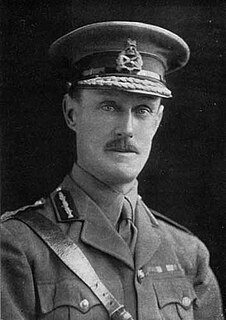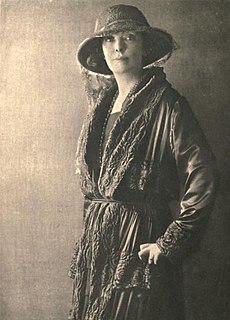Related Research Articles

Lieutenant-General Bernard Cyril Freyberg, 1st Baron Freyberg, was a British-born New Zealand soldier and Victoria Cross recipient, who served as the 7th Governor-General of New Zealand from 1946 to 1952.
Sir Harold Delf Gillies was a New Zealand otolaryngologist and father of modern plastic surgery.

Air Chief Marshal Sir Keith Rodney Park, was a New Zealander who served as a senior RAF officer. An ANZAC Gallipoli Veteran and Second World War Royal Air Force commander, he was placed in command of No. 11 Group of the RAF - the Group responsible for the defence of South East England and London. Due to the strategic significance and geographic location concerning the Luftwaffe, Park’s Group bore the brunt of the German aerial assault during the Battle of Britain.
The Royal New Zealand Army Medical Corps (RNZAMC) is a corps of the New Zealand Army, the land branch of the New Zealand Defence Force (NZDF). The Medical Corps provides for the medical needs of soldiers, such as diagnosing and treating diseases and injuries. Medical personnel are part of almost all Army exercises and operations, and personnel work in conjunction with personnel from the Royal New Zealand Dental Corps and the Royal New Zealand Nursing Corps.

General Sir Alexander John Godley, was a senior British Army officer. He is best known for his role as commander of the New Zealand Expeditionary Force and II Anzac Corps during the First World War.
The following lists events that happened during 1916 in New Zealand.
The Institute of Advanced Legal Studies (IALS) is a member institute of the School of Advanced Study, University of London. Founded in 1947, it is a national academic centre of excellence, serving the legal community and universities across the United Kingdom and the world through legal scholarship, facilities, and its comparative law library.

Major General Sir Andrew Hamilton Russell was a senior officer of the New Zealand Military Forces who served during the First World War.

The Charge of the Light Brigade was a failed military action involving the British light cavalry led by Lord Cardigan against Russian forces during the Battle of Balaclava on 25 October 1854 in the Crimean War. Lord Raglan had intended to send the Light Brigade to prevent the Russians from removing captured guns from overrun Turkish positions, a task for which the light cavalry were well-suited. However, there was miscommunication in the chain of command and the Light Brigade was instead sent on a frontal assault against a different artillery battery, one well-prepared with excellent fields of defensive fire. The Light Brigade reached the battery under withering direct fire and scattered some of the gunners, but they were forced to retreat immediately, and the assault ended with very high British casualties and no decisive gains.

Hôpital Temporaire d'Arc-en-Barrois was an emergency evacuation hospital serving the French 3rd Army Corps during World War I. It was organised and staffed by British volunteers and served French soldiers.

Grey Towers was a crenellated mansion with 85 acres of grounds on Hornchurch Road in Hornchurch, England. It was built in 1876 and brought into public use as the New Zealand Convalescent Hospital during the First World War. In the interwar period Hornchurch was developed as a suburb and Grey Towers was demolished to be used for housing.
The Victoria League for Commonwealth Friendship (1901–present) is a voluntary charitable organisation that connects people from Commonwealth countries. There are currently branches in the UK, Australia, and New Zealand with affiliated organisations in Canada and the USA. It is headquartered in Bayswater, London, United Kingdom.

Lady Angela Selina Bianca Forbes was a British socialite and novelist who was known as a forces sweetheart for organising soldiers' canteens in France during the First World War. She reverted to her maiden name in 1929.

Bob Kerr is an author, illustrator and artist based in Wellington, New Zealand. He writes and illustrates children’s books and has won several awards for his work. He lives and works in Wellington, New Zealand.
The 1918 War Honours in New Zealand were appointments by King George V to the Order of the British Empire to recognise services in or for New Zealand in connection with World War I. They were announced on 4 October 1918.
The Mothercraft Training Society was an organization in the United Kingdom which trained expectant and new mothers, nurses, midwives, and health visitors in 'mothercraft', with the aim of bringing down infant mortality. Briefly known as the Babies of the Empire Society, before taking on its new name, it established its own infant welfare clinic, with a dietetic hospital, and ran a year-long training course from which students emerged as qualified nursery nurses.

Mary Alice Blair (1880–1962) was a New Zealand doctor who organised hospitals in Malta, Serbia and Salonika during the First World War. She was in charge of Serbian hospital evacuation to Corsica where she was responsible for the thousands of refugees. She was awarded the Serbian Medal of St Sava and mentioned in despatches for her distinguished service. An anaesthetist, trained in New Zealand and Britain, Blair was described as one of “the great women of anaesthesia.”

Mary H J Henderson was an administrator with Elsie Inglis's Scottish Women's Hospitals for Foreign Service in the Balkans in World War I, earning five medals. She founded social work and civic groups led by women, in Dundee, Aberdeen and London and served on charitable bodies including Dundee War Relief Fund, and worked for women's suffrage. She was also a war poet.

Queen Mary Hospital, in Hanmer Springs, New Zealand is a former residential alcohol and drug treatment hospital. It opened in 1916 to treat returned servicemen from World War I, on the site of a sanatorium built in 1879. From the 1920s to 1960s it treated mental health conditions generally but in the 1970s it became the national specialist addiction and alcohol treatment centre. The hospital closed in November 2003. The Queen Mary Hospital (Former) and Hanmer Springs Thermal Reserve Historic Area was designated as a historic site by Heritage New Zealand in 2004. Within that area three buildings, the Soldiers' Block, Nurses' Home and Chisholm Block, were given Category I protection by Heritage New Zealand in 2005.
Wilfred Stanley Wallis was a New Zealand doctor of orthopaedics and medical administrator, who served as a medical officer during the First World War.
References
- ↑ "NEW ZEALAND SOLDIERS' CLUB". Marlborough Express. 25 July 1916.
- ↑ Lane, Michael R. (1989). The Rendel Connection: a dynasty of engineers . Quiller Press. pp. 224. ISBN 1870948017.
- ↑ Reeves, William Pember. "Chapter X: In the Caudine Forks". The Long White Cloud: Ao Tea Roa. New Zealand Electronic Texts Centre (NZETC). Retrieved 20 August 2012.
- ↑ "NEW SOLDIERS' CLUB. The Opening Ceremony. A Well-Appointed Institution". The Colonist. 3 August 1916.
- ↑ "Institute of Advanced Legal Studies homepage".
- ↑ "New Zealand Soldiers' Club, (17) Russell Square". IALS. Archived from the original on 2016-03-03. Retrieved 2012-08-20.
- ↑ "N.Z. Soldiers' Club in London. How it is Managed. An Interesting Letter". Press. 28 September 1916.
- ↑ Daniels, John ("Jack"). "Just of Postcard: the Daniels Family at War". Archived from the original on 8 February 2013. Retrieved 20 August 2012.
{{cite web}}: CS1 maint: bot: original URL status unknown (link)